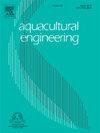Carbon dot-graphene composite: A novel biocide for marine biofouling control in aquaculture cage nets
IF 4.3
2区 农林科学
Q2 AGRICULTURAL ENGINEERING
引用次数: 0
Abstract
Recently, heightened concern and reluctance among planners and fishers about using inorganic biocides in aquatic systems have increased the importance of carbon-based nanomaterials, which are free from metallic contaminants and non-toxic to the environment and biota. The study aimed to synthesize carbon dot (CD) from fish eye and to fabricate a CD-graphene composite to test its efficacy as biocide against marine biofouling. The organic components of fish eyes were hydrothermally transformed into fluorescent nano carbon dots as evidenced by their FTIR signatures, fluorescence and UV-Visible spectra. The fish eye CD-graphene composite synthesized hydrothermally and was studied for its chemical and morphological characteristics. A nano-sized CD-graphene composite is formed with a few disorganized layers exhibiting an amorphous nature. Different concentrations of CD-graphene were coated onto surface-modified polyethylene aquaculture cage nets using polyaniline and exposed to the marine environment for 8 months to evaluate the composite's effectiveness as an antifouling agent. The treated cage net exhibited excellent biofouling resistance and the optimum concentration of CD-graphene for efficient resistance was 0.02 %. The study attributed the biocidal mechanism of the composites to the synergistic activity of CDs and graphene under sunlight, which generates ROS and free radical species. This process disrupts microbial biofilm formation on cage nets, leading to enhanced biofouling resistance.
Synopsis
The synthesized fish eye waste derived carbon dot-graphene composite, offers a non-toxic, metal-free antifouling solution for aquaculture systems, effectively reducing marine biofouling through sunlight-driven reactive oxygen species and free radical generation.
碳点-石墨烯复合材料:一种用于控制水产养殖网箱海洋生物污染的新型杀菌剂
最近,规划者和渔民对在水生系统中使用无机杀菌剂的高度关注和不情愿增加了碳基纳米材料的重要性,因为碳基纳米材料不含金属污染物,对环境和生物群无毒。该研究旨在从鱼眼中合成碳点(CD),并制造CD-石墨烯复合材料,以测试其作为生物杀灭剂对海洋生物污染的功效。鱼眼的有机成分经水热转化为荧光纳米碳点,其FTIR特征、荧光和紫外可见光谱均得到证实。采用水热法合成鱼眼cd -石墨烯复合材料,并对其化学和形态特征进行了研究。一个纳米尺寸的cd -石墨烯复合材料形成了一些无序的层,表现出无定形的性质。采用聚苯胺将不同浓度的cd -石墨烯涂覆在表面改性的聚乙烯水产养殖笼网上,并将其暴露在海洋环境中8个月,以评估该复合材料作为防污剂的有效性。处理后的笼网具有良好的抗生物污染性能,cd -石墨烯的最佳抗污染浓度为0.02 %。该研究将复合材料的生物杀灭机制归因于CDs和石墨烯在阳光下的协同作用,产生ROS和自由基。这一过程破坏了笼网上微生物生物膜的形成,从而增强了抗生物污染的能力。合成的鱼眼废物衍生的碳点-石墨烯复合材料,为水产养殖系统提供了一种无毒,无金属的防污解决方案,有效减少了通过阳光驱动的活性氧和自由基的产生而产生的海洋生物污染。
本文章由计算机程序翻译,如有差异,请以英文原文为准。
求助全文
约1分钟内获得全文
求助全文
来源期刊

Aquacultural Engineering
农林科学-农业工程
CiteScore
8.60
自引率
10.00%
发文量
63
审稿时长
>24 weeks
期刊介绍:
Aquacultural Engineering is concerned with the design and development of effective aquacultural systems for marine and freshwater facilities. The journal aims to apply the knowledge gained from basic research which potentially can be translated into commercial operations.
Problems of scale-up and application of research data involve many parameters, both physical and biological, making it difficult to anticipate the interaction between the unit processes and the cultured animals. Aquacultural Engineering aims to develop this bioengineering interface for aquaculture and welcomes contributions in the following areas:
– Engineering and design of aquaculture facilities
– Engineering-based research studies
– Construction experience and techniques
– In-service experience, commissioning, operation
– Materials selection and their uses
– Quantification of biological data and constraints
 求助内容:
求助内容: 应助结果提醒方式:
应助结果提醒方式:


